Encouraging early outcomes shown for minimally invasive radiation therapy
Episcleral brachytherapy may be a viable approach to treating AMD that avoids vitreous surgery, according to a small study.
A new investigative therapy to treat neovascular age-related macular degeneration demonstrated encouraging results in a phase 1 evaluation, according to a presentation at Retina 2012.
“Sub-Tenon episcleral brachytherapy is an elegant, potentially safe, minimally invasive approach that avoids vitrectomy,” Reid F. Schindler, MD, said in a follow-up email interview with Ocular Surgery News. “We have determined that the probe can be placed and the brachytherapy delivered with reasonable ease and minimal, if any, discomfort.”
Dr. Schindler presented data from a 90-day trial of six patients with classic or occult neovascular lesions who had undergone persistent prior treatment or were newly diagnosed. In addition to radiation therapy, patients received anti-VEGF treatment as induction and additional injections as needed.
Developed by Salutaris Medical Devices, the radiation device is a transilluminated probe placed behind the posterior sclera that applies 24 Gy single-fraction beta brachytherapy to the subfoveal neovascular membrane. According to Dr. Schindler, this approach aims to be an outpatient procedure under local anesthesia, and surgery should take approximately 15 minutes.
Distinguishing episcleral, epimacular brachytherapy
A presentation at Angiogenesis, Exudation and Degeneration 2012 suggested that a related therapy may not achieve desired outcomes. The CABERNET study, which evaluated strontium-90 epimacular brachytherapy (NeoVista) for treatment of CNV secondary to AMD, did not meet its primary endpoint at 2 years.
According to presenter Pravin U. Dugel, MD, the trial showed this form of brachytherapy to be safe and effective for a subgroup of patients, but visual acuity results did not meet the endpoint with a 10% non-inferiority margin.
However, the two approaches differ significantly, Dr. Schindler noted. For instance, the epimacular approach delivers radiation through a cannula inserted intraocularly following vitrectomy.
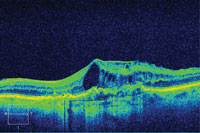
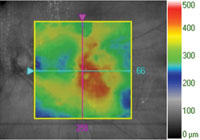
Baseline. BCVA: 20/63 +1. Protocol anti-VEGF injection. 24 Gy brachytherapy.
Source: SalutarisMD

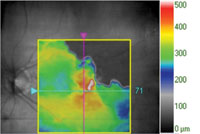
30-day follow-up. BCVA: 20/63 +2 (+1 ETDRS letter). Protocol anti-VEGF injection.
Source: SalutarisMD
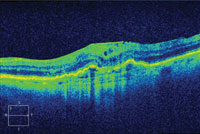
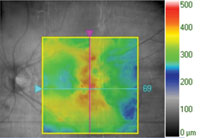
60-day follow-up. BCVA: 20/63 +2 (+1 ETDRS letter). No anti-VEGF injection.
Source: SalutarisMD
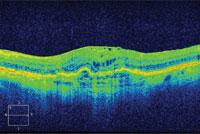
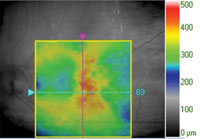
90-day follow-up. BCVA: 20/50 -1 (+ 3 ETDRS letters). No anti-VEGF injection.
Source: SalutarisMD

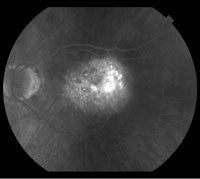
Both images (right and left) show the patient at baseline after at least 11 previous injections and before initiation of the study treatment (brachytherapy).
Source: SalutarisMD
“Our episcleral approach does not violate the globe. Brachytherapy is delivered extraocularly by advancing the device cannula under Tenon’s capsule to a position on the sclera overlying the wet AMD lesion. This episcleral placement allows for consistent, stable geometry and repeatable control of the distance to the target tissue,” Dr. Schindler said.
Additionally, potential risk to normal tissue may be lower.
“In the episcleral approach, the highest radiation dose is at the sclera, which is generally tolerant to high dose radiation. The retina lies beyond the target and always receives a smaller dose of radiation,” he said.
Early results
Dr. Schindler reported safe treatment of choroidal neovascularization and no serious or unanticipated adverse events. The study results were not intended to be extrapolated for statistical significance, but individual subjects were tracked and all patients showed improvement in best corrected visual acuity, according to a press release from SalutarisMD.
“The results of the initial cohort of subjects in our phase 1 trial are encouraging and warrant further clinical investigation,” Dr. Schindler said. The next step is completion of phase 1.
The study was limited by its small sample size and short follow-up period, Dr. Schindler and colleagues said, but it provides compelling reasons to continue developing and evaluating this alternative approach to brachytherapy.
“We believe that the episcleral approach has the advantage of avoiding more invasive surgical techniques and can deliver localized tissue treatment performed under the direct care of a retina specialist with consistent stable geometry,” Dr. Schindler said. “The device is designed as a practical, office-based procedure that can be performed in the same clinical environment as anti-VEGF injections.” – by Michelle Pagnani and David W. Mullin
For more information:
- Reid F. Schindler, MD, can be reached at the Retina Specialists of Southern Arizona, 4753 East Camp Lowell Drive, Tucson, AZ 85712; 520-881-1400; email: hquinn@retinaspecialistsAZ.com.
- Disclosure: Dr. Schindler is a member of the scientific advisory board for SalutarisMD, with an associated minor equity position in the company.
